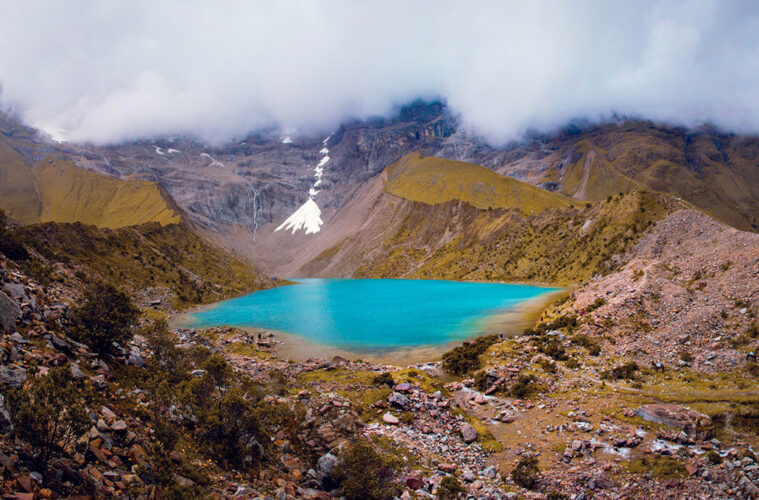Travellers can admire the Cordilliera Vilcabamba’s snow-capped peaks while hiking the Salkantay trek, named one of the 25 best treks in the world by National Geographic Adventure Travel Magazine. In order to reach Machu Picchu, the symbol of Peru, one must travel through mountains and glaciers that leave explorers breathless. There is nothing like the incredible connection to nature, observing stunning landscapes and vibrant flora and fauna of a tropical jungle. Meeting farming communities and tasting local products is also a great opportunity for a cultural experience. Are you willing to give it a try?
Plan your Salantay Trek to Machu Picchu
Explorers can reach Machu Picchu and explore Peru’s incredible culture and nature in just four days by hiking 72 kilometres during this wonderful Salkantay trek. This can be a challenging experience in terms of natural conditions and physical strength required, but the picturesque landscape of the Salktantay Snowy Mountains makes it all worth it. Reaching Machu Picchu, one of the 7 Wonders of the World, is worth all your effort.
On the first day, it’s a good idea to follow the route from Cusco, through Challacancha and Humantay, and to finish the day in Soraypamapa, at an altitude of 3,850 meters (12,631 feet). On the way, there will be time for snacks or lunch, but it’s best to be accompanied by a professional guide, who knows the mountains and can help you cover the route safely.
The second day is equally challenging, and being aware of the increasing altitude is important. From the highest point in the Salkantay Pass, which is 4,650 meters (15,367 feet), enjoy the view of the second-highest mountain in Cusco and the surrounding glaciers. The second campsite after reaching Wayraqmachay is Chawllay.
On day three, we will be travelling to Santa Teresa, with the first stop at Lucmabamba. During this trip, we will have the chance to experience the local culture and witness their daily activities. This is a great opportunity to taste the amazing fruits of the region, as well as purchase local products such as chocolate and coffee. Once we arrive at Santa Teresa or Cocalmayo, we can take the time to relax in thermal baths surrounded by rock formations and bushes, which will be a great way to unwind after a challenging day.
On day four of your journey, you will leave Santa Teresa and arrive at Llactapata, which is famous for its incredible coffee plantations and artisan mills. This will be a wonderful opportunity to experience cultivation and harvesting in their traditional form. After reaching the Llactapata pass, we will have lunch at the Hydroelectric station, which will be the final point before taking the train to Aguas Calientes.
You can enjoy a comfortable stay in the hotel before the last day, which aims to reach Machu Picchu. Consider paying for a guided tour to experience the main temples, squares, and other architectural gems of Machu Picchu.
What does the route look like?
Planning the whole tour is the first step that needs to be taken, to know exactly how to organise all the details, such as logistics or the necessary permits, as some of the routes have a limit of visitors to 500 per day (200 tourists and 300 porters, cooks, and guides). The permits were necessary to protect the landscape of the 7 Wonders of the World. The permit is necessary when the iconic Inca Trail is chosen, but the Salkantay trek is not limited.
Because of the altitude and the challenging location of the Saltanay trek, it is important to focus on the possible logistic solutions. Many explorers decide to use the service of specialised agencies responsible for the organisation of most of the details, including transportation.
It is possible in some places to take a shared taxi, unless enough people are willing to travel with you, and a driver who will take you to your destination. One part of the tour must be taken by train. There are a few entrance tickets that need to be bought to enter the places, including the ticket to Huaynapicchu, Machu Picchu Mountain, or the hot springs in Aguas Calientes.
Most meals are included in the guided tour price, and there is no need to organise the food on your own. Remember there are no hostels or shelters built on the route, which requires independent travellers to buy and take their tent, sleeping bag, and sleeping pad. With a guided tour, explorers receive the service of a porter, who prepares meals and accommodation before tourists reach the base. Camping is possible everywhere, but it is important to mind the route for cows or horses.
What to bring to the Salkantay trek?
It is necessary to remember to take comfortable shoes to the trek, bearing in mind long distances to walk, high altitudes and rocks on the route. The clothes should be light, but warm. Take a hat, a wool hat, gloves, sunglasses, sunscreen, and especially between November to April, rain gear. Take an additional set of clothes to wear after the tour finishes. If you are planning a visit to Aguas Calientes, take a bathing suit and a towel.
Personal hygiene items are really important, so take toilet paper, a toothbrush and toothpaste, wet towels, and personal medication. One of the most crucial items to take is insect repellent. A passport or DNI is mandatory for the tour, similar to the travel insurance and local currency.
For your safety after the sunset, take a flashlight or small headlights, and a photo camera to take pictures of the breathtaking views. Pack as lightly as possible, use a backpack not bigger than 25 litres, which you wouldn’t be able to enter Machu Picchu with.



